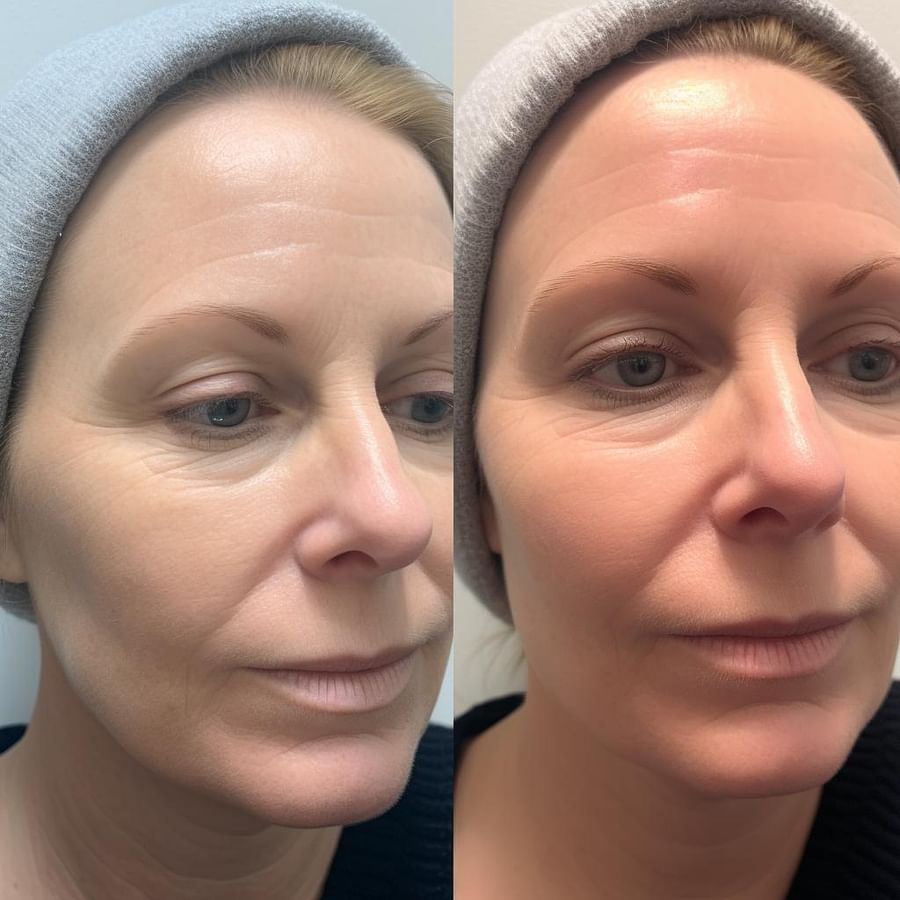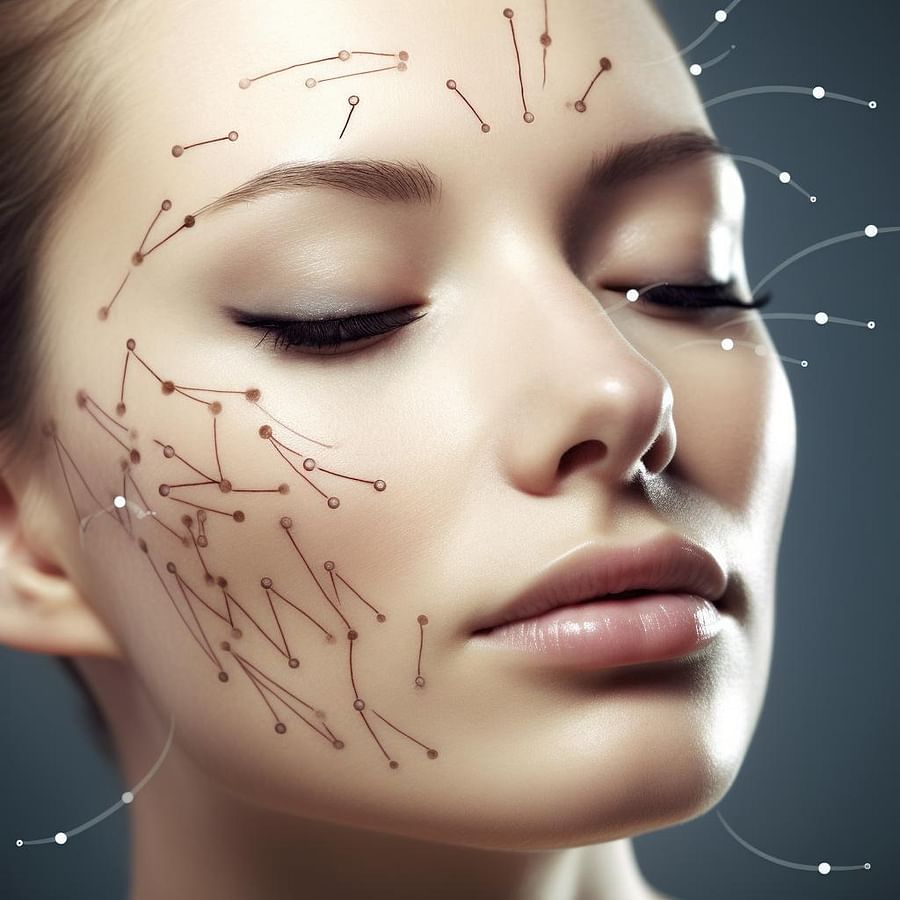How Many Units of Botox for Forehead: A Complete Guide

Botox forehead treatment is a popular non-surgical cosmetic procedure that reduces the appearance of fine lines and wrinkles on the forehead. It uses Botox (Botulinum toxin type A), a neurotoxin that temporarily paralyzes the muscles responsible for creating wrinkles. This smooths out the skin, giving it a more youthful and refreshed appearance.
Patients seek Botox forehead treatment to address horizontal forehead lines, frown lines (also known as "11" lines), and crow's feet. These wrinkles are caused by repetitive muscle movements like squinting, frowning, or raising the eyebrows. Over time, these actions cause the skin to crease and form lines that become more pronounced with age.

One key factor in achieving optimal results with Botox forehead treatment is determining the appropriate dosage, or Botox forehead units. Using too few units may not produce the desired effect, while using too many units can lead to an unnatural, "frozen" appearance or complications like drooping eyelids.
When considering Botox injection for the forehead, consult with a qualified and experienced medical professional who can assess your needs and recommend the appropriate Botox dosage. They consider factors like the severity of your wrinkles, desired outcome, and facial anatomy to determine the most suitable dosage. You can learn more about this in our beginner's guide to understanding Botox treatments.
Follow your practitioner's forehead Botox tips and aftercare instructions to ensure the best results and minimize potential side effects. This may include avoiding certain activities and following specific skincare routines.
In the following sections, we will delve deeper into determining the right Botox forehead units, the procedure of Botox injection on the forehead, and expert tips for achieving the best results with Botox forehead treatment. For more information on Botox treatments, explore our latest trends and innovations in cosmetic Botox treatments.
When achieving the best results with Botox forehead treatment, determining the right number of Botox forehead units is crucial. The appropriate dosage varies from person to person, depending on factors like the severity of wrinkles, facial anatomy, and desired outcomes. In this section, we will discuss the process of determining the right Botox forehead units for your needs. This is part of our comprehensive guide on using Botox for wrinkles and lines.
Consult with a qualified and experienced medical professional who specializes in Botox injections. They will evaluate your features, skin condition, and the depth of your wrinkles to recommend the most suitable Botox dosage. This personalized approach ensures you receive the optimal units to achieve your desired results without over-treating the area. You can learn more about the process and benefits of Botox Brow Lift and Botox under the eyes from our detailed articles.

Typically, the number of Botox units required for forehead treatment ranges from 10 to 30 units. However, this is just a general guideline, and the actual dosage may vary depending on your unique needs. Individuals with more pronounced wrinkles or stronger facial muscles may require a higher number of units, while those with milder wrinkles or weaker muscles may need fewer units.
The forehead Botox dosage should be adjusted gradually, especially for first-time patients. Your practitioner may start with a conservative dosage and assess the results after two weeks. If necessary, they can administer additional units during a follow-up appointment to fine-tune the results and achieve the desired muscle relaxation and wrinkle reduction.
Remember, the goal of Botox injection forehead treatment is a natural, refreshed appearance. By working closely with a skilled medical professional and following their advice, you can ensure the right Botox forehead units are used for the best outcome. You can also explore other Botox treatments like Botox for gummy smiles and Botox for TMJ for a more comprehensive approach to facial aesthetics.
In the next section, we will discuss the process of Botox injection on the forehead, providing you with a comprehensive forehead Botox guide to understand what to expect during the procedure.
Understanding the process of Botox injection on the forehead is essential for anyone considering this treatment. This section of our comprehensive forehead Botox guide will walk you through the steps involved in the procedure, ensuring you have a clear idea of what to expect.
Step 1: Consultation and Assessment
Before the Botox injection, your medical professional will conduct a thorough consultation and assessment of your features, skin condition, and the severity of your wrinkles. This evaluation determines the appropriate Botox dosage for forehead treatment and identifies the injection sites for the best results.
Step 2: Preparing the Injection Site
Once the consultation is complete, your practitioner will clean the treatment area with an antiseptic solution. This minimizes the risk of infection and ensures the injection site is clean.
Step 3: Marking the Injection Points
Using a fine-tipped marker, your medical professional will mark the specific points on your forehead where the Botox injections will be administered. These markings guide the injection process, ensuring accurate delivery to the targeted muscles.

Step 4: Administering the Botox Injections
Using a fine needle, your practitioner will inject the predetermined Botox forehead units into the marked points on your forehead. The injections are quick and relatively painless, with most patients describing a slight pinch or sting. Topical anesthetic can be requested to numb the area before injections if you are sensitive to pain.

Step 5: Post-Injection Care
After the Botox injections, your medical professional will provide post-treatment care instructions. This may include avoiding strenuous activities, heat exposure, and lying down for a few hours. Following these guidelines minimizes the risk of side effects and ensures optimal results.
In conclusion, the process of Botox injection on the forehead is straightforward and minimally invasive. By understanding the steps involved and following your practitioner's advice, you can ensure a smooth and successful Botox forehead treatment experience. In the following sections of our forehead Botox guide, we will discuss dosage recommendations, factors to consider when determining Botox units for the forehead, and expert tips for achieving the best results with your Botox forehead treatment.
Now that you have a better understanding of the Botox injection process for the forehead, let's delve deeper into the forehead Botox guide by discussing dosage and tips for achieving the best results. The right Botox dosage for forehead treatment ensures a natural, rejuvenated appearance while minimizing side effects. It's also important to consider other areas where Botox can be beneficial, such as Masseter Botox for jawline slimming and contouring or Botox for facial asymmetry.
Forehead Botox Dosage
When it comes to Botox forehead units, there is no one-size-fits-all approach. The appropriate dosage varies depending on factors like muscle strength, severity of wrinkles, and desired outcome. Generally, the Botox dosage for forehead ranges between 10 and 30 units, with most patients requiring around 15 to 20 units for optimal results. Your medical professional determines the exact dosage based on their assessment during the consultation.
Forehead Botox Tips
Here are some expert tips to help you achieve the best results with your Botox forehead treatment:
1. Choose an experienced practitioner: Select a practitioner with extensive experience in administering Botox injections, particularly in the forehead area.
2. Communicate your desired outcome: Be open and honest about your expectations and the results you hope to achieve. This helps your practitioner tailor the treatment to your needs and preferences.
3. Follow post-treatment care instructions: Adhere to the guidelines provided by your medical professional to minimize side effects and ensure optimal results. This may include avoiding certain activities and following specific skincare routines.
4. Be patient: It may take up to two weeks for the full effects of your Botox treatment to become visible. Avoid touching or massaging the treated area during this time to prevent unintended migration of the Botox. Remember, Botox is not just for the forehead. It can also be used to treat conditions like TMJ or to enhance your smile by treating smile lines.
5. Consider maintenance treatments: Botox is temporary, with results lasting between three to six months. Schedule regular maintenance treatments as recommended by your medical professional to maintain your rejuvenated appearance.

In summary, understanding the appropriate forehead Botox dosage and following expert tips can help you achieve the best results with your Botox forehead treatment. Work closely with your medical professional and follow their guidance to enjoy a smoother, more youthful appearance with minimal side effects. And remember, Botox can be used in various ways, from treating smile lines to helping with TMJ and more.
When determining the appropriate Botox units for forehead treatment, several factors come into play. Understanding these factors helps tailor the treatment to your needs and ensure the best results. Here are key factors to consider when deciding on the Botox dosage for your forehead:
1. Muscle Strength: The strength of the muscles in the forehead area significantly impacts the number of Botox units required. Individuals with stronger muscles may need a higher dosage to achieve the desired relaxation and wrinkle reduction. Your medical professional assesses your muscle strength during the consultation to determine the appropriate Botox units.
2. Severity of Wrinkles: The depth and severity of the wrinkles on your forehead influence the Botox dosage. Deeper, more pronounced wrinkles may require a higher number of units for optimal results. Individuals with milder wrinkles may need fewer units to achieve a smoother appearance.
3. Desired Outcome: Your preferences and desired results play a crucial role in determining the Botox units for your forehead treatment. Some individuals prefer a subtle, natural-looking result, while others desire a more dramatic transformation. Communicate your expectations with your medical professional to adjust the dosage accordingly.
4. Age and Skin Elasticity: Age and skin elasticity can impact the Botox dosage for your forehead. As we age, our skin loses elasticity, and wrinkles become more pronounced. Older individuals or those with less elastic skin may require a higher dosage for desired results.
5. Previous Botox Treatments: If you have had Botox treatments in the past, your medical professional may consider your previous experiences when determining the appropriate dosage. They may adjust the units based on the effectiveness of past treatments and any side effects experienced.
In conclusion, several factors influence the appropriate Botox units for forehead treatment. By considering muscle strength, severity of wrinkles, desired outcome, age, skin elasticity, and previous Botox treatments, your medical professional tailors the treatment to your needs for optimal results. Communicate openly with your practitioner and follow their guidance to achieve a rejuvenated, youthful appearance.

Now that you understand the factors that influence the appropriate Botox units for forehead treatment, let's delve into a comprehensive guide on the dosage for forehead Botox. This guide provides a better understanding of the typical Botox forehead units and helps you make informed decisions about your treatment.
Botox Forehead Units: General Guidelines
While the exact number of Botox units needed for your forehead treatment varies based on the factors discussed earlier, there are general guidelines to consider. On average, most individuals require between 10 to 30 units of Botox for forehead treatment. However, this range can vary depending on your specific needs and desired outcome.
Initial Consultation and Assessment
During your initial consultation, your medical professional assesses your forehead area and discusses your desired results. They take into account muscle strength, severity of wrinkles, age, skin elasticity, and any previous Botox treatments to determine the appropriate Botox dosage for your forehead. Open and honest communication during this consultation ensures the best possible outcome.
Adjusting Botox Dosage Over Time
As you continue to receive Botox treatments, your medical professional may adjust the dosage based on your results and any changes in your skin or muscle strength. Maintain open communication with your practitioner and provide feedback on your satisfaction with the treatment. This allows them to make any necessary adjustments to your Botox forehead units for optimal results.
Expert Tips for Achieving the Best Results with Botox Forehead Treatment
Here are expert tips to help you achieve the best results with your Botox forehead treatment:

In conclusion, understanding the appropriate dosage for forehead Botox is essential for achieving the best results. By considering the factors that influence Botox units and following expert tips, you can ensure a successful and satisfying Botox forehead treatment experience.
Now that you have a comprehensive understanding of the dosage for forehead Botox, let's explore expert tips to help you achieve the best results with your Botox forehead treatment. By following these recommendations, you can ensure a successful and satisfying experience.
1. Choose a qualified and experienced medical professional
Select a qualified and experienced medical professional to administer your Botox injections. This ensures safe and effective treatment and knowledge about the appropriate Botox forehead units for your needs.
2. Follow pre- and post-treatment care instructions
Adhere to your practitioner's pre- and post-treatment care instructions to minimize side effects and promote optimal healing. This may include avoiding certain medications, applying ice to the injection site, and refraining from strenuous activities for a short period after the treatment.
3. Be patient and give the Botox time to work
Remember that the full effects of Botox can take up to two weeks to become visible. Be patient and avoid making judgments about the results until this time has passed.
4. Maintain a consistent treatment schedule
To maintain your desired results, keep a consistent treatment schedule. Botox treatments typically last between three to six months, so regular appointments are necessary to keep your forehead looking smooth and youthful.
5. Communicate openly with your practitioner
Open communication with your medical professional is key to achieving the best results. Provide feedback on your satisfaction with the treatment and any concerns you may have, allowing them to make any necessary adjustments to your Botox forehead units and overall treatment plan.
6. Consider complementary treatments
In some cases, combining Botox with other treatments like dermal fillers or laser resurfacing can enhance your overall results. Discuss these options with your practitioner to determine the best course of action for your needs and goals.

By following these expert tips and working closely with your medical professional, you can ensure a successful and satisfying Botox forehead treatment experience. Remember, the key to achieving the best results lies in understanding the appropriate Botox dosage for your forehead and following the recommendations provided by your practitioner.
Post a comment